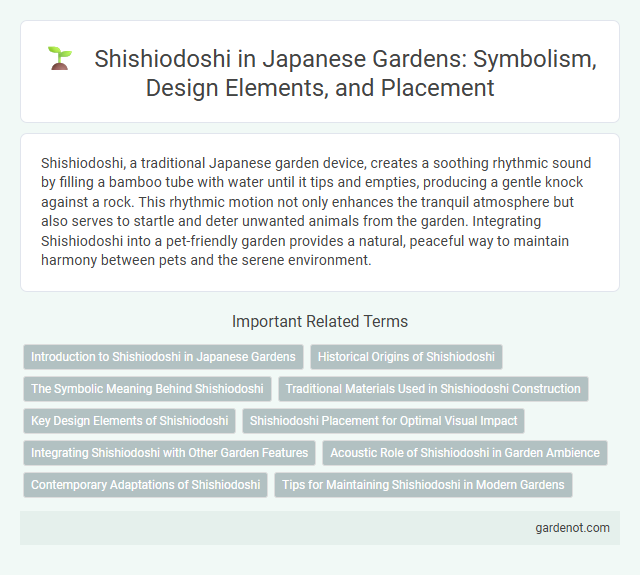Shishiodoshi, a traditional Japanese garden device, creates a soothing rhythmic sound by filling a bamboo tube with water until it tips and empties, producing a gentle knock against a rock. This rhythmic motion not only enhances the tranquil atmosphere but also serves to startle and deter unwanted animals from the garden. Integrating Shishiodoshi into a pet-friendly garden provides a natural, peaceful way to maintain harmony between pets and the serene environment.
Introduction to Shishiodoshi in Japanese Gardens
Shishiodoshi, a traditional Japanese garden feature, combines functionality with aesthetic appeal by creating rhythmic sounds to enhance tranquility. This device typically consists of a bamboo tube that fills with water and tips to empty, producing a distinctive clacking noise that symbolizes nature's cycle. Originating from Edo period gardens, Shishiodoshi serves both to gently startle animals and to provide a meditative audio element in garden design.
Historical Origins of Shishiodoshi
Shishiodoshi, or "deer scarers," originated in Japan during the Edo period as a traditional water fountain designed to startle and deter deer and boars from gardens and rice fields. Crafted from bamboo, these devices operate by filling with water until they tip over, creating a distinctive knocking sound upon striking a rock, which also adds rhythmic auditory elements to Japanese garden aesthetics. Their historical significance lies in blending utility with Zen principles, symbolizing harmony between nature and human intervention in landscape design.
The Symbolic Meaning Behind Shishiodoshi
Shishiodoshi, a traditional Japanese bamboo water fountain, symbolizes the harmony between man and nature through its rhythmic sound representing the flow of life. This device, originally designed to scare away deer and other pests, now embodies mindfulness and tranquility in Japanese garden design. Its repetitive knocking sound serves as a meditative reminder of nature's presence and the passage of time within the serene garden setting.
Traditional Materials Used in Shishiodoshi Construction
Shishiodoshi, a traditional Japanese garden water feature, is primarily constructed from bamboo, known for its durability and natural aesthetic. The frame typically incorporates natural wood, often cedar or cypress, valued for its resistance to moisture and decay. Rock or stone bases are used to stabilize the structure and enhance the garden's harmonious design through natural textures.
Key Design Elements of Shishiodoshi
Shishiodoshi features a bamboo tube pivoted to fill with water and then empty with a distinctive clacking sound, serving both aesthetic and functional purposes in Japanese gardens. Key design elements include natural bamboo construction, a carefully balanced fulcrum for smooth tilting, and placement near water sources to maintain consistent flow. The gentle sound produced mimics natural bird calls, enhancing the tranquil atmosphere and deterring animals from garden crops.
Shishiodoshi Placement for Optimal Visual Impact
Shishiodoshi placement in a Japanese garden is crucial for achieving optimal visual impact and enhancing the garden's serene ambiance. Positioning the shishiodoshi near water features or among carefully arranged rocks accentuates natural sound and movement, drawing attention without overwhelming the surrounding landscape. Strategic placement ensures the rhythmic knocking sound complements garden pathways and viewpoints, creating a harmonious sensory experience.
Integrating Shishiodoshi with Other Garden Features
Integrating Shishiodoshi with other garden features enhances the tranquil ambiance by combining the rhythmic water sound with natural elements like koi ponds, stone lanterns, and bamboo fences. Positioning the Shishiodoshi near moss-covered stones or amidst flowering shrubs enriches the sensory experience and emphasizes harmony within traditional Japanese garden design. Thoughtful placement ensures the water's gentle clacking complements the visual serenity, creating a balanced environment that promotes meditation and relaxation.
Acoustic Role of Shishiodoshi in Garden Ambience
Shishiodoshi, a traditional Japanese bamboo water fountain, plays a crucial acoustic role in garden ambience by producing a rhythmic knocking sound that enhances tranquility and encourages mindfulness. This gentle, repetitive noise masks urban distractions, creating a serene auditory environment that complements the visual aesthetics of the garden. The sound of water striking stone promotes relaxation and deepens the sensory experience, embodying the principle of "ma," or mindful space, in Japanese garden design.
Contemporary Adaptations of Shishiodoshi
Contemporary adaptations of the Shishiodoshi incorporate modern materials such as stainless steel and bamboo composites to enhance durability while preserving traditional aesthetics. Designers integrate automated water flow systems and adjustable sound mechanisms to create customizable sensory experiences in urban garden spaces. These innovations maintain the Shishiodoshi's symbolic function of tranquility and nature's rhythm, aligning with minimalist and eco-friendly landscape design trends worldwide.
Tips for Maintaining Shishiodoshi in Modern Gardens
Regularly check the bamboo tube and pivot joint of the Shishiodoshi for signs of wear to ensure smooth water flow and the signature rhythmic sound. Use filtered water to prevent mineral buildup inside the mechanism, which can hinder its function and reduce lifespan. Position the Shishiodoshi in shaded areas to minimize deterioration from harsh sunlight and maintain its natural aesthetic in modern gardens.
Shishiodoshi Infographic

 gardenot.com
gardenot.com